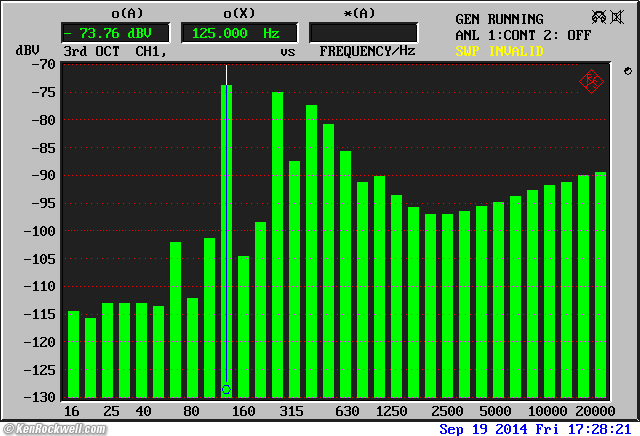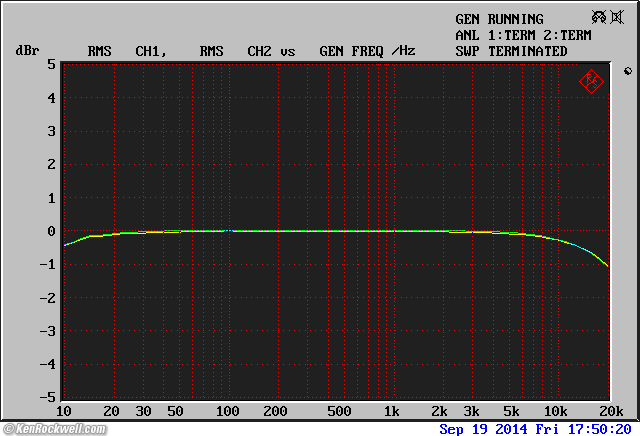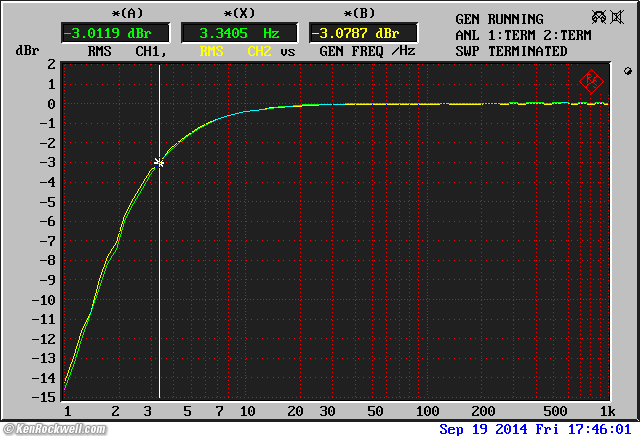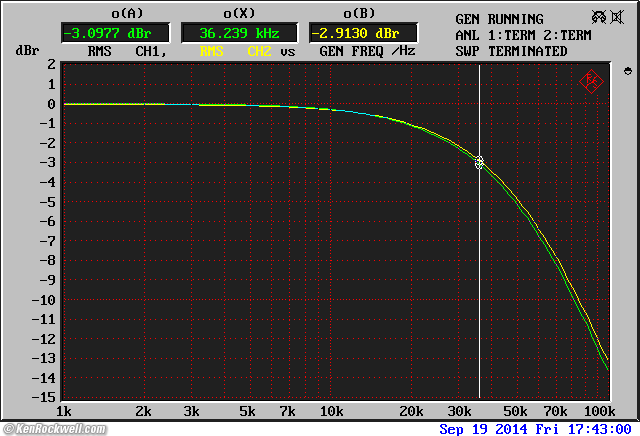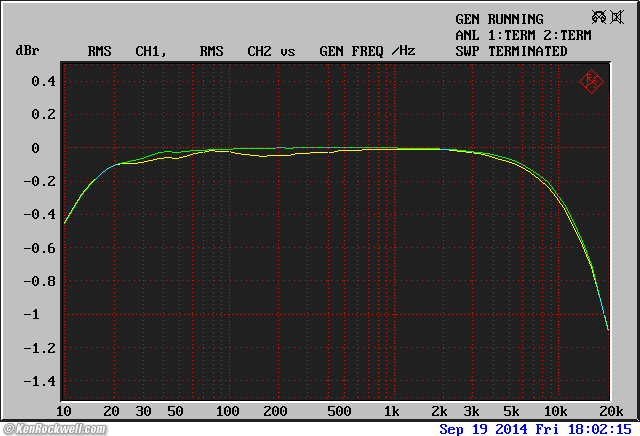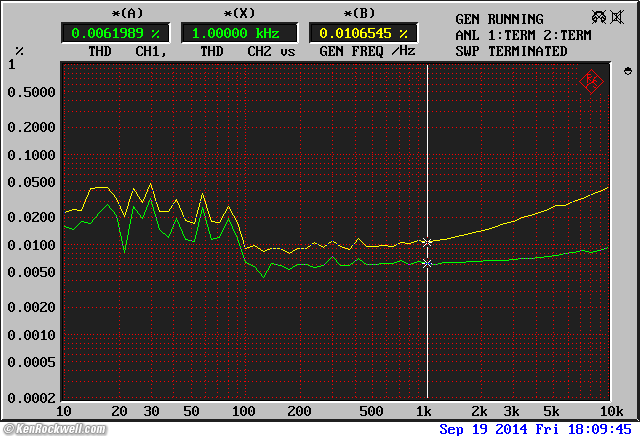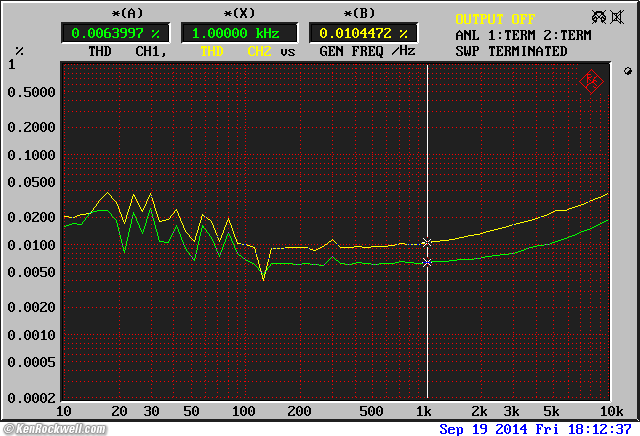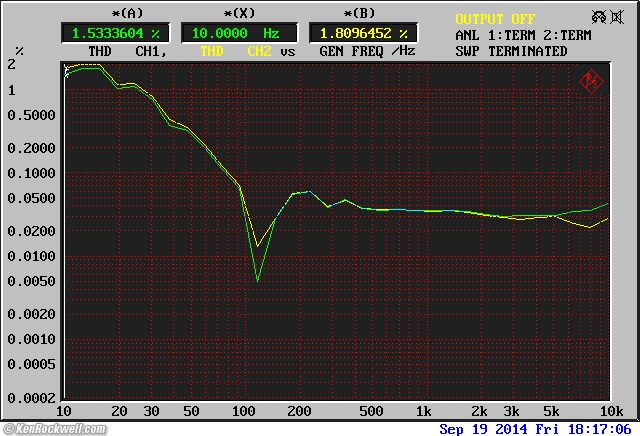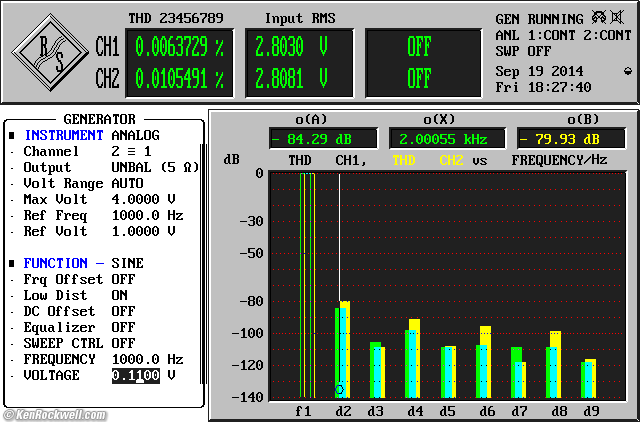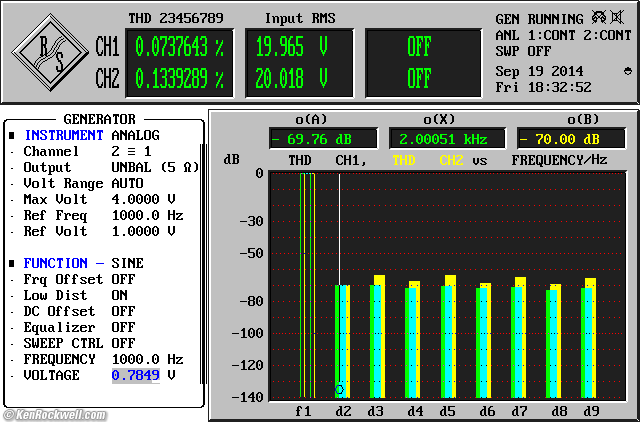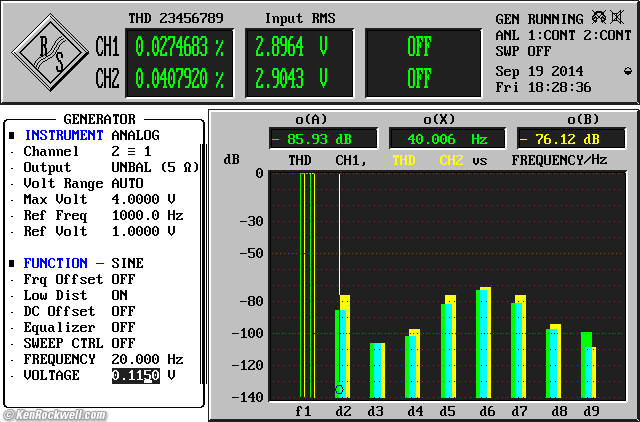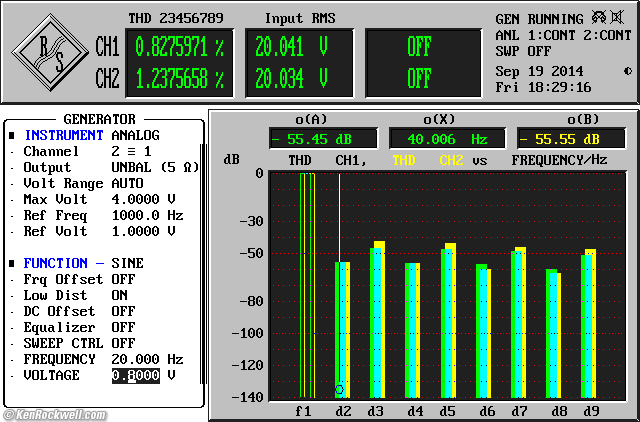Home Donate New Search Gallery Reviews How-To Books Links Workshops About Contact
AudioSource AMP 100
50 WPC Remote Stereo Amplifier
(c. 2007-)
© 2014 KenRockwell.com. All rights reserved.
Intro Specifications Measurements Compared
AudioSource AMP 100 (automatic power on/off with audio input, rated 50 watts per channel into 8Ω, 9.6 lbs./4.4 kg, measured 6 watts standby and 10 watts idle power draw, about $125 new or about $90 used). enlarge. I got this mine at this link to them at Amazon; B&H has them and you can get them used at eBay (see How to Win at eBay).
Rear, AudioSource AMP 100. enlarge.
This free website's biggest source of support is when you use those or any of these links to approved sources when you get anything, regardless of the country in which you live — but I receive nothing for my efforts if you take the chance of buying elsewhere. I get no government hand-outs and run no pledge drives to support my research, so please always use any of these links to approved sources for the best prices, service and selection whenever you get anything. Thanks for helping me help you! Ken.
September 2014 Audio reviews all reviews
Introduction top
Intro Specifications Measurements Compared
The AudioSource AMP 100 is a very capable little class A/B stereo power amplifier whose main feature is that it switches its power on and off automatically with the presence of an audio signal.
When plugged into speakers and an Apple Airport Express, you or any guest using your wireless network now can play music through your speakers — without touching or doing anything other than a few taps on their Mac, Mac Book, iPhone, iPod or iPad!
You tap to send audio to the speaker or speakers of your choice from your device, and the system turns itself on and start playing — with no need ever to touch this amplifier or any other external controls! You can control what's playing and which speakers play how loud all from your iPhone or other device, and the system turns itself on or off as needed. You certainly no longer need a $15,000 custom A/V system or a dedicated Mac Mini as a server; you can play direct from your device, or use Apple's free Remote app to play anything from iTunes on your Mac to any set or sets of speakers. Bravo!
Since AirPlay is native in every iPhone, iPad, Mac and iPod Touch, any guests to your home can play their music directly to your system, no downloads needed. They will be impressed!
The AMP 100 has two stereo inputs, and it automatically turns on and selects whichever is active. Input 1 has priority if both are active, and there is an output which always follows Input 2.
Used as intended, feed your remote house audio into Input 2. (You can daisy-chain the next unit from the Line 2 Out if you like.) Connect a local TV or CD player etc. into Input 1. Now the AMP 100 plays whenever the Master House Audio signal is there, and if someone walks up to it and wants to play something locally, it magically just plays that.
The AMP 100 is perfect for use at each zone of a multi-room audio system. I use an Apple Airport Express connected to an AMP 100 in each area of my house, and for $220 for amp and AirPort combined it does the same thing as a $500 Sonos connect amp.
Another advantage of the AMP 100 for serious installations is that it's trivial to insert dedicated equalizers, bass alignment filters, bi-amp crossovers or stereo subwoofer splits between the AirPort Express source and the input of the AMP 100 — something you can't do with the integrated amp of the Sonos even at twice the price.
Here's how to save $15,000 from paying an installer for a whole-house music system:
1.) Install a huge wireless network if needed. Normal homes are fine with just one wireless router.
2.) Put an Apple Airport Express and an AMP 100 into each zone in which you want to play music. (These will also extend your wireless network all over your house.)
2.) Plug the AirPort Express into the AMP 100 with a 3.5mm to RCA cord, plug them both into the wall (there's an unswitched power outlet on the back of the AMP 100 if you only have one outlet), connect your speakers to the AMP 100, and you're done. You can play to any of these through your iPhone, iPad or iPod Touch or from iTunes on your computer.
Easy! Here's how to control the system from your mobile device.
Circuit Design
The AMP 100 is a traditional class AB linear Hi-Fi power amplifier in a sheet metal steel case.
Hallelujah; I was afraid it was going to be some junky class D garbage.
Supposedly it has a toroidal power transformer.
Specifications top
Intro Specifications Measurements Compared
Output Power
Stereo
8Ω
50 WPC into 8Ω from 20-20,000 Hz with < 0.02% THD+N.
60 WPC into 8Ω a 1 kHz with < 0.02% THD+N.
4Ω
60 WPC into 8Ω from 20-20,000 Hz with < 0.02% THD+N.
75 WPC into 8Ω a 1 kHz with < 0.02% THD+N.
Audio Input
Two stereo pairs of 1/4" RCA jacks.
1.5 V RMS input specified in AudioSource's specifications.
900mV input for 50W into 8Ω specified in User's Manual.
Output Connectors
Twisty semi-standard binding posts on standard 3/4" centers.
The top half with the banana jack turns as a unit, connected to the base by a screw thread; it's not a real 5-way post where the base and socket are part of the chassis.
Each post accepts a banana plug, bare wire or pin lead. You can't get a spade or ring lug in it.
Total four pairs or 8 posts.
Frequency Response
20 - 20,000 Hz.
Signal to Noise Ratio
100 dB A-weighted below 50W into 8Ω.
Channel Separation
65 dB at 1 kHz at 50 W.
Power Input
117 VAC, 60 Hz (US version).
Marked 500 W maximum.
Actual power consumption is much less.
Quality
Made in China.
Packaging
Corrugated cardboard box.
Amplifier supported by two polystyrene foam end caps.
Size
2.9 x 16.5 x 9.5 inches, HWD, including feet, switches and connectors.
74 x 419 x 242 millimeters, HWD, including feet, switches and connectors.
Weight
9.6 pounds (4.4 kg).
10.8 pounds (4.9 kg) shipping weight.
Price, USA
September 2014: $125 new or about $90 used.
Measurements top
Intro Specifications Measurements Compared
Gain Channel Balance Tracking Balance Control
Damping Factors Noise SNR DC Offset
Frequency Response Square Waves THD DFD
Actual Power Consumption 4Ω Operation
These laboratory measurements are made with an exotic Rohde & Schwarz UPL laboratory analyzer. The traces from the Rohde & Schwarz UPL laboratory analyzer are color coded for the Left Channel and for the Right Channel. When they don't lie on top of each other, it's due to channel imbalance. When they do lie on top of each other, the trace turns blue.
Unless otherwise specified, all measurements are RMS at 1 watt continuous output per channel at 1 kHz with an 8 Ω load, both channels driven with a 117 VAC 60 Hz supply.
Gain measurements top
Maximum: 28.162 dB left, 28.115 dB right.
Knob set to |
Gain |
Maximum |
28.1 dB |
4 o'clock |
26.1 dB |
3 o'clock |
20.2 dB |
2 o'clock |
16.5 dB |
1 o'clock |
12.6 dB |
12 o'clock |
8.3 dB |
11 o'clock |
4.9 dB |
10 o'clock |
-1.3 dB |
9 o'clock |
-8.3 dB |
8 o'clock |
-21.9 dB |
Minimum |
-79 dB |
Channel Balance measurements top
At maximum gain, the right channel is 0.036 dB lower than the left.
This is perfect.
Tracking measurements top
![]()
AudioSource AMP 100 Channel Tracking (up means image moves to left).
This is superb channel tracking for a real dual potentiometer. I'm impressed!
Balance Control measurements top
Right vs. Left |
|
Full Left |
-60.6 dB |
8 o'clock |
-7.6 dB |
9 o'clock |
-2.2 dB |
10 o'clock |
-0.7 dB |
11 o'clock |
-0.2 dB |
Center |
-0.036 dB |
1 o'clock |
+0.1 dB |
2 o'clock |
+0.6 dB |
3 o'clock |
+2.0 dB |
4 o'clock |
+7.3 dB |
Full Right |
+52.7 dB |
No surprises, it's an ordinary balance control.
Input Levels measurements top
At maximum gain:
Stereo 8Ω
111 mV for 1 W output.
351 mV for 10 W output.
784 mV for 50 W output at 0.01% THD.
799 mV for 52 W output at 0.1% THD.
930 mV for 66 W output in 10mS bursts at clipping.
980 mV for 76.6 W output in 1mS bursts at clipping.
Stereo 4Ω
79 mV for 1 W output into 4Ω.
659 mV for 70 W output into 4Ω.
920 mV for 130 W RMS in 1mS bursts at clipping into 4Ω at 1 burst per second.
Power Output measurements top
All are continuous RMS measurements at 0.1% THD at 1 kHz into 8Ω with a 117 VAC supply unless otherwise noted:
8Ω
52 watts per channel into 8Ω, both channels driven continuously at 1 kHz at 0.1% THD.
Burst Power
66 W output at clipping for 10mS bursts at clipping.
76.6 W output at clipping for 1mS bursts at clipping.
4Ω
70 watts per channel into 4Ω, both channels driven continuously at 1 kHz at 0.1% THD.
Burst Power
130 W into 4Ω at clipping in 1ms bursts of 1 kHz at one burst per second.
Damping Factors measurements top
Output Source Impedance |
4Ω Damping Factor |
8Ω Damping Factor |
|
50 Hz |
24.2 mΩ |
163 |
329 |
1 kHz |
18 mΩ |
220 |
440 |
20 kHz |
32.5 mΩ |
123 |
246 |
I'm impressed again, this is better than many very expensive Hi-Fi amplifiers.
Output Noise measurements top
The noise is unchanged regardless of the setting of the gain (volume) control.
AMP 100 noise spectral analysis.
A Weighted |
Unweighted |
-78 dBV A |
-71 dBV |
Signal to Noise Ratio (SNR) measurements top
87 dB A-weighted SNR (14.3 effective bits) referred to 1 watt into 8Ω (2.83 V or +9.031 dBV).
104.0 dB A-weighted SNR (17.1 effective bits) referred to 50 watts into 8Ω (20 V or +26/02 dBV).
Output DC Offset measurements top
+0.6 mV left, +2 mV right.
This again is very good, better than most more expensive amplifiers.
Frequency Response measurements top
AMP 100 frequency response into 8Ω.
Perfect, flat across the critical bass frequencies. The 1 dB loss at 20 kHz will make the sound very slightly smoother.
AMP 100 infrasonic frequency response into 8Ω.
-3 dB at 3.4 Hz, perfect.
AMP 100 ultrasonic frequency response into 8Ω.
-3 dB at 36 kHz. This is perfect for this application, since it makes it much less likely that typical ground loops and other gotchas will lead to oscillation. It also reduces the response to ultrasonic hash coming from SACD sources or other clever wireless devices.
This is driving an 8Ω resistor, which doesn't count in the real world. Let's see what it does driving a real loudspeaker:
AMP 100 driving an 8Ω resistor and driving a B&W Matrix 805 loudspeaker (yellow).
Marvelous, there's only a +0, -0.05 dB variation. This is better than many much more expensive amplifiers.
Square Waves measurements top
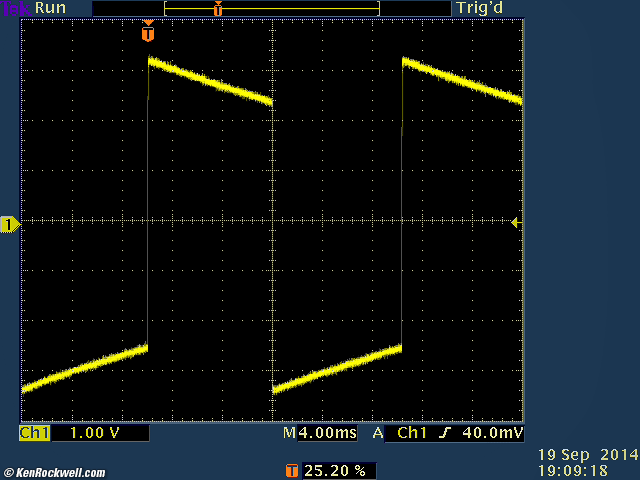
50 Hz square wave. (HP 209A, Tek TDS3052, Tek P6139A.)
Perfect for its bandwidth.

1 kHz square wave. (HP 209A, Tek TDS3052, Tek P6139A.)
Perfect!
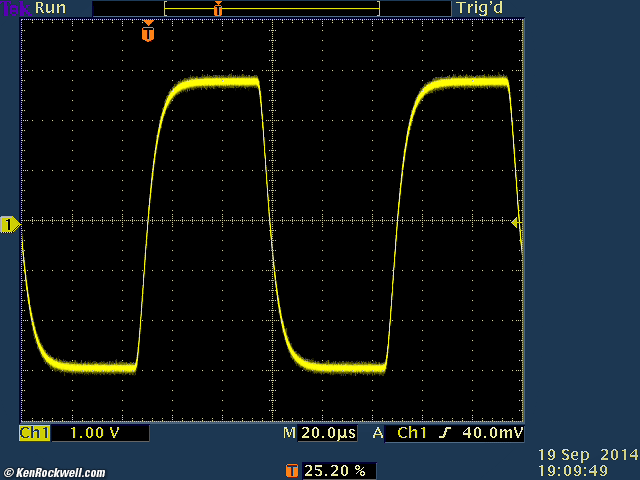
10 kHz square wave. (HP 209A, Tek TDS3052, Tek P6139A.)
Again, for its bandwidth, perfect.

50 Hz square wave driving a B&W Matrix 805 loudspeaker. (HP 209A, Tek TDS3052, Tek P6139A.)
Wow, unchanged from driving a resistor.
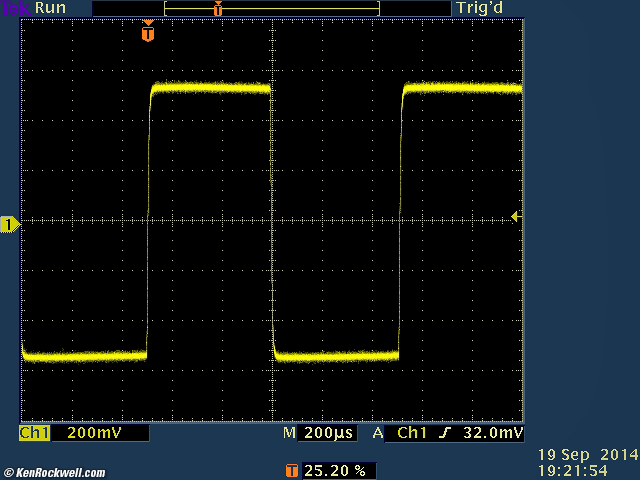
1 kHz square wave driving a B&W Matrix 805 loudspeaker. (HP 209A, Tek TDS3052, Tek P6139A.)
Perfect! Unchanged from driving a resistor.
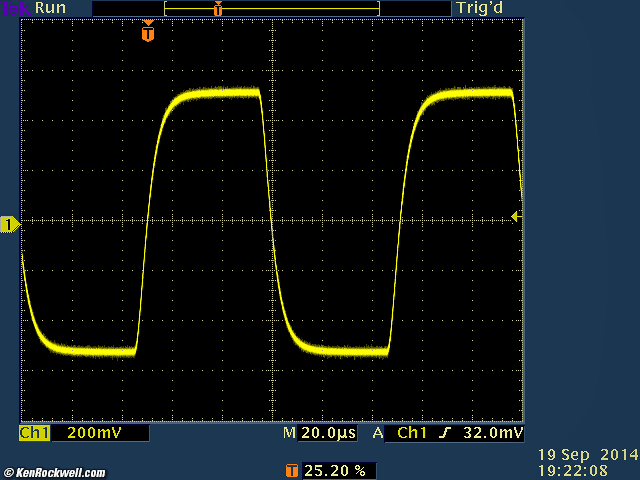
10 kHz square wave driving a B&W Matrix 805 loudspeaker. (HP 209A, Tek TDS3052, Tek P6139A.)
Again, unchanged from driving a resistor. This is superb; most exotic amplifiers aren't this good.
THD: 0.01% (-80 dB) measurements top
All these THD measurements are measuring pure distortion components only (THD only), not noise and distortion (THD+N). THD+N numbers would be worse than THD alone shown here.
THD versus frequency into 8 Ω
AMP 100 THD versus frequency at 1 watt, 8Ω load.
It's the same at 10 mW, with the power supply interference raised 20 dB.
AMP 100 THD versus frequency at 10 watts, 8Ω load.
Same as at 1W.
AMP 100 THD versus frequency at 50 watts, 8Ω load.
Whoa! What's this with the low frequencies at high power? I bet it's a wimpy power supply. I'm not going to worry, even $5,000 speakers have far more distortion at 20 Hz and 50W than does this amplifier
The THD isn't audible at about 0.01%, but not as good as great amplifiers that cost ten times as much.
Harmonic Distortion Components at 1 watt
AMP 100 harmonic distortion content, 1 kHz at 1 watt, 8Ω load.
Aha! It's not the lowest distortion, but it is mostly second and even-order, which is fine — like a tube amp.
Harmonic Distortion Components at 50 watts
AMP 100 harmonic distortion content at 50 W.
As expected, at high power near clipping the harmonics are all about equal.
Let's see if we can learn anything at low frequencies:
AMP 100 harmonic distortion content at 20 cycles at 1 W.
Weird.
AMP 100 harmonic distortion content at 20 cycles at 50 W.
Mostly odd-order harmonics again suggests a wimpy power supply.
19+20 kHz Difference-Frequency Distortion (DFD)
per DIN IEC 268-3 or 118:
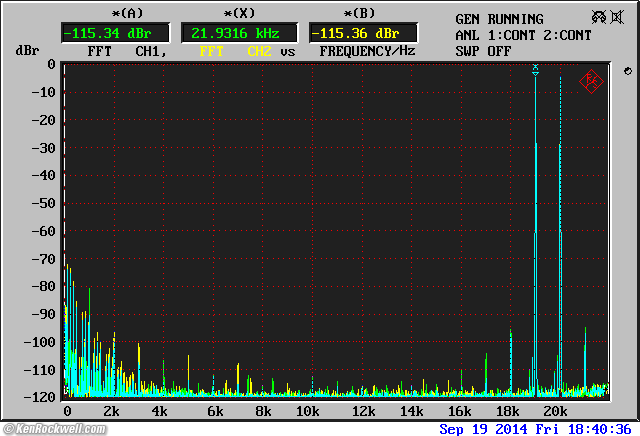
DFD at 1 W RMS total output.
The 1 kHz component is -80 dB, which isn't as good as a really good Hi-Fi amp, but tough, what do you want for $150 brand new?

DFD at 10 W RMS total output.
The 1 kHz component is around -72 dB, which is fair.
The close-in 18 kHz and 21 kHz skirts are at -95 dB, which is swell.

DFD at 50 W RMS total output.
The 1 kHz component is at about -83 dB, which is again only fair.
The close-in 18 kHz and 21 kHz skirts are at -94 dB, which are swell .
Actual Power Consumption measurements top
The AMP 100 runs moderately warm. It's always comfortable to touch and never gets hot if well ventilated.
Output |
Power Consumption |
Efficiency |
Power off |
zero. |
n/a |
Standby (red LED) |
6.25 W (0.08 A) |
0 % |
Idle, cold (Green LED) |
11.2 W (0.15 A) |
0 % |
Idle, warm (Green LED) |
10 W |
0 % |
1 WPC |
32.1 W (0.43 A) |
6.2 % |
10 WPC |
90 W (1.04 A) |
22.2 % |
50 WPC |
175 W (1.90 A) |
57.1 % |
52 WPC |
180 W (1.93 A) |
57.8 % |
70 WPC (4Ω) |
274 W (2.79 A) |
51.1% |
4Ω Operation measurements top
It's perfectly happy at 4Ω, no surprises here.
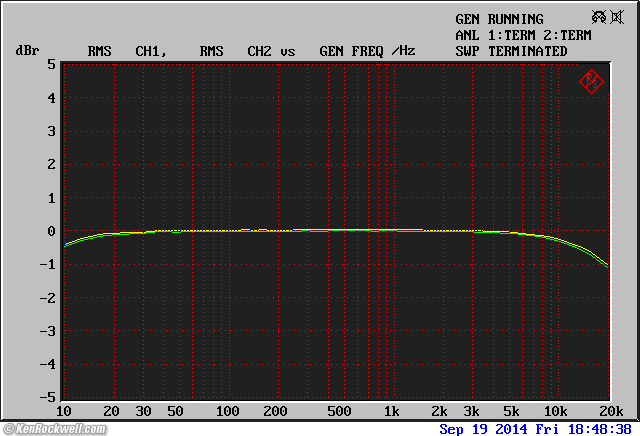
Frequency response driving 4Ω.
Perfect! Same as at 8Ω.
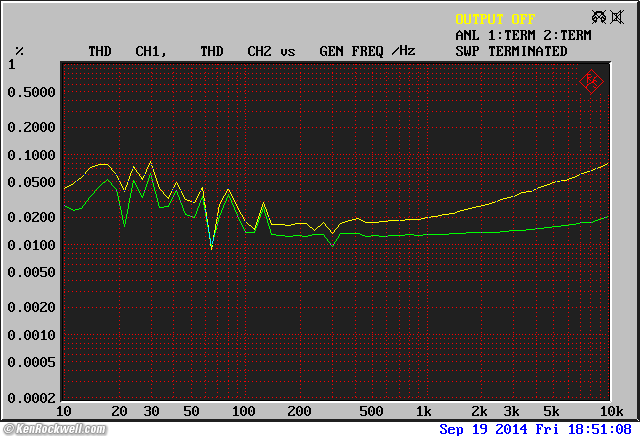
THD driving 4Ω at 1 watt.
THD is a little higher than at 8Ω, exactly as we'd expect.
Compared top
Intro Specifications Measurements Compared
Versus Class D
As a real class A/B linear power amplifier, its performance is far better than class D designs.
For instance, this $125 amplifier uses less power, has less distortion, has much better damping factors, has less noise and has much flatter frequency response than the $600 Musical Fidelity M1PWR class D amplifier.
Versus Sonos
I haven't tried the Sonos connect amp yet.
I have heard that Sonos is really great equipment and that an advantage is that the Sonos won't drift between zones, so that hours later all your zones will still be in sync. I'm told that an AirPort network may get a little out of step if you have all zones playing and audible at the same time for hours and hours.
An Apple Airport Express connected to an AMP 100 does same thing as a $500 Sonos connect amp, with less configuration and probably better audio quality. The lightweight Sonos looks much prettier, but only has a class D amplifier — and it requires buying more hardware like the Sonos bridge before it actually can play anything.
I haven't tried Sonos yet. It's probably awesome, but it is twice the price; and I need all those AirPorts anyway to extend my wireless network.
I believe you need to load an app from Sonos for it to work on your mobile device, while the AirPort system I use is already native in everyone's iPhone/iPad and iPod Touch.
Versus Savant
I haven't used Savant. As I understand it, Savant also allows one also to control your pool, your lights, your security system and cameras and thermostats. Of course buying the special controllers for each and every light switch or thermostat gets expensive very quickly.
An installer gave me a quote for a Savant system just for our TVs and music, and it was $15,000 — and that used a new Mac Mini computer as one more server I'd have to load with my media instead of just playing from my existing Mac Pro's iTunes library.
I suspect one wouldn't need the Mac Mini, but the sad part is that I told the installer what I wanted: the ability to pick up my phone and just make the system play music right from my phone, and his quote was for something way more complex.
Hey, all I want to do is pick up my phone and use it to make my music play around the house as easily as possible.
Ask a good home installer for more about Savant. I'm not familiar with it; all I know was that it was central in a quote I got for something that didn't do what I asked for it to do.
Versus great Hi-Fi amplifiers
For pure audio quality, a dedicated classic amplifier like the Hafler DH-120 performs better, but when one realizes that the whole point of this AMP 100 is its automatic power feature for remote-controlled music systems, this AMP 100 is the best I've found.
No real Hi-Fi amplifier has automatic power switching. I wouldn't want to waste the power that a great Hi-Fi amp burns 24/7 just so it would play without having to go find the switch.
Usage top
Intro Specifications Measurements Compared
Automatic Power Control
The main feature is the auto power turn-on. To use it, set the rear switch to AUTO and push-in the front power switch.
There's a red/green LED in the power switch. Green is ON and red is standby.
The right channel is the only one monitored to turn-on power; applying signal on the left channel only won't wake the amp.
Either INPUT 1 or INPUT 2 will wake the amplifier.
Power stays on for 10 minutes after the audio input turns off.
Audio Inputs
The back panel is mislabeled. Use INPUT 2 as the main input from your remote audio system.
Use INPUT 1 as the secondary input from a local audio source.
The AMP 100 switches to play from whichever input is active. If they are both active, INPUT 1 has priority.
This way it will switch on and play by magic from the master system, and if anyone walks up to the amp and wants to play something from a local source, the AMP 100 will switch to it automatically.
If playing INPUT 2, it switches to INPUT 1 as soon as audio appears. If INPUT 1 goes silent, 7 seconds later it switches back to INPUT 2. This ensures that it won't switch back to the master system between songs played locally.
The LINE 2 OUT always feeds the signal from INPUT 2, even if the local INPUT 1 is playing. This lets you daisy-chain a master audio feed around the house if you like.
Speaker Switches
Each speaker switch has a red LED that lights if it's ON.
To play both pairs of speakers at once, hold both buttons in at the same time. TO release one, press the other.
Recommendations top
Intro Specifications Measurements Compared
The AMP 100 is perfect for driving remote zones of speakers. AudioSource also makes more powerful versions of the same thing as you can see at their page, but 50 WPC is more than enough.
This amp makes far more sense to me than anything else for remote control. Just plug it into the output from an AirPort Express or the "remote second room" preamp outputs of a receiver, and it switches itself on by magic and just plays.
If you want to play your multi-room system into good passive speakers, this is how you do it.
If you find this information useful, my biggest source of support is when you use these links to them at Amazon or at B&H or used at eBay (see How to Win at eBay) when yiou get yours. Please always use any of these links to approved sources for the best prices, service and selection whenever you get anything.
Thanks for helping me help you!
Ken.
More Information top
Intro Specifications Measurements Compared
AudioSource AMP 100 User's Manual.
AudioSource AMP 100 specifications.
Help me help you top
I support my growing family through this website, as crazy as it might seem.
The biggest help is when you use any of these links when you get anything, regardless of the country in which you live. It costs you nothing, and is this site's, and thus my family's, biggest source of support. These places have the best prices and service, which is why I've used them since before this website existed. I recommend them all personally.
If you find this page as helpful as a book you might have had to buy or a workshop you may have had to take, feel free to help me continue helping everyone.
If you've gotten your gear through one of my links or helped otherwise, you're family. It's great people like you who allow me to keep adding to this site full-time. Thanks!
If you haven't helped yet, please do, and consider helping me with a gift of $5.00.
As this page is copyrighted and formally registered, it is unlawful to make copies, especially in the form of printouts for personal use. If you wish to make a printout for personal use, you are granted one-time permission only if you PayPal me $5.00 per printout or part thereof. Thank you!
Thanks for reading!
Mr. & Mrs. Ken Rockwell, Ryan and Katie.
Home Donate New Search Gallery Reviews How-To Books Links Workshops About Contact





